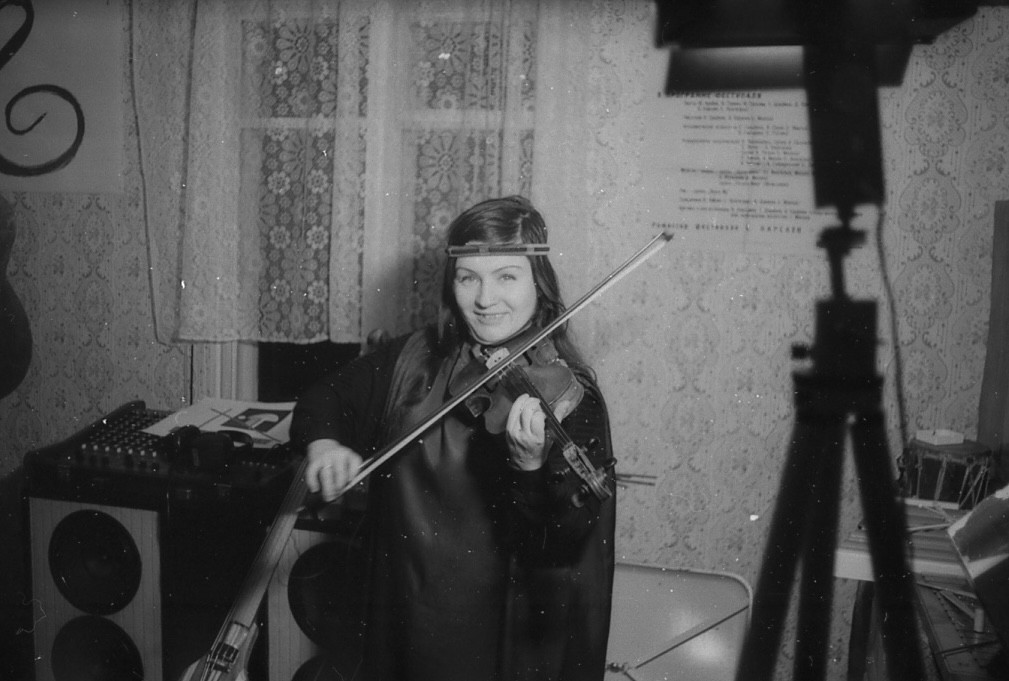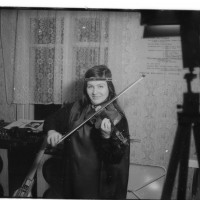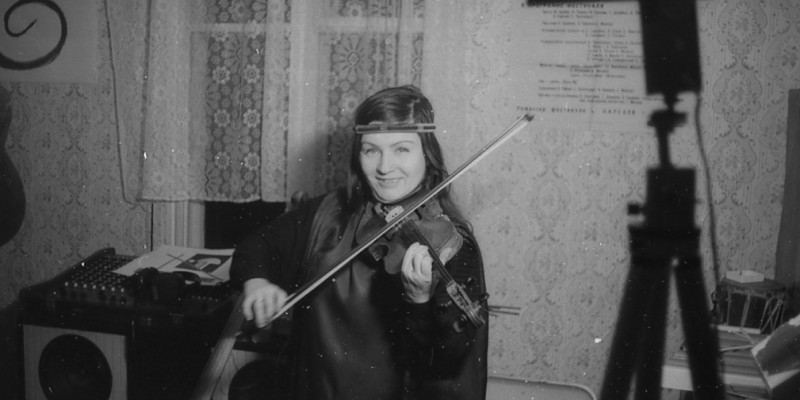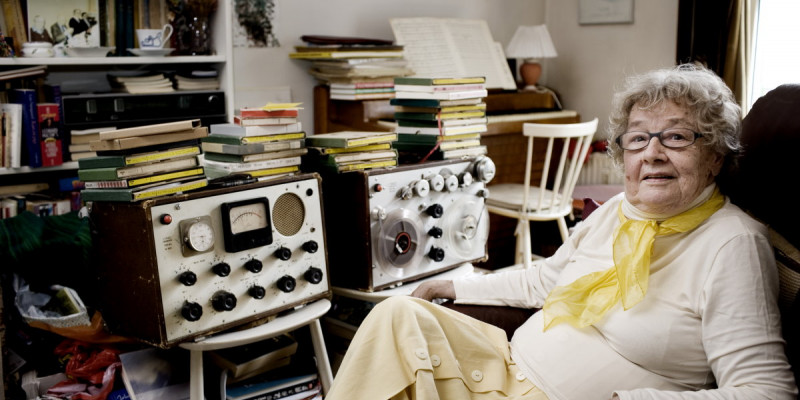
Gender, Canon, and Eastern European Women Pioneers of 20th-century Electronic Music
Within recent decades, there has been a trend of researchers and music curators rediscovering and popularizing a growing number of electronic music pieces by 20th-century women composers. Often in these cases, the new (or not-so-new) women composers are presented as forgotten »pioneers« and »trailblazers« of electronic music. This includes Western European electronic music composers such as Éliane Radigue and, more recently, Else Marie Pade, as well as many other – mostly American and British – women featured in Lisa Rovner’s 2020 documentary Sisters with Transistors.1 Music researchers involved with this recuperative work claim legitimacy and recognition for these previously-forgotten women composers of electronic music by arguing that their work belongs – or, rather, should belong – to the canon of electronic music. That is, next to the first row of the »big male names« of European electronic and experimental music such as Pierre Schaeffer, Pierre Boulez, and Karlheinz Stockhausen.
In response to framing women composers relative to a canon, feminist music critics – for whom the recognition for the musical output of women is a particularly urgent endeavour – have taken issue with valorizing women’s contributions to music in this way. In fact, critics have pointed out the various ways in which the very concept of »canon« is troublesome in the first place.
Like gender, canons continue to replicate themselves
Gender – Canon
Skepticism towards canons and metanarratives (or, at least, the awareness of their limitations) is one of the fundamental tenets of New Musicology, an academic paradigm which has set the standard for the study and research of music history in the West.2 The reasons behind the fading trust in canons overlap with feminist critiques of the historiography of art and music more broadly: the Western musical canon has formed and reproduced itself within elite social groups (usually comprised of higher-class white men) and institutions (the Western conservatory, concert hall, electronic music studio) to which, historically, women and other underprivileged groups had little to no access.3 Established values around music have tended to exclude many musical genres, instruments, and forms of expression – especially those belonging to folk, Indigenous, »amateur«, and popular music traditions. Even a post-structuralist approach of acknowledging the presence of multiple canons of music – such as canons based on performance tradition, music for academic study, different genres, and so on – rather than a single musical canon does little to resolve the fundamental issues around what music becomes part of a canon and why. Finally, canons encourage us to imagine music history as a series of hierarchies, a progression of exceptional individuals who made it to the podium while everybody else around them has been doomed to oblivion. Canons conceal the collaborative, network-based, plural nature of musical creativity.
Can we then make the Western canon – and especially the electronic music canon – more feminist?
When we consider the domain of electronic music, the traits read onto technology and its musical means go some way towards explaining the overall masculine bent of its canon. At the same time, as noted by Marie Thompson, sonic experimentalism is often »imagined as autonomous from gender; its musical spaces are thought of as ‘post-gender’ or ‘gender-neutral.’«4 Yet gender continues to operate in such seemingly »post-gender« spaces. Like gender, canons continue to replicate themselves, even in new pathways of artistic creation – like electronic music in its own time. In fact, originality and transgression in art are the very stuff of canon, and they are also inherently gendered musical values. As Thompson recognizes, the history of noise in music, and of sonic experimentalism more generally, frequently creates a patrilineal ‘dotted line’ of innovators, inventors and agitators. […] [T]he participation of female artists in the noisy fields of experimental and electronic music has been sidelined, […] women’s contributions to these fields have often been marginalised in canonical written texts.5
And so, canons persist. In fact, the existence of what we know as »electronic music canon« or »experimental music canon« is but one testament to the canon’s persistence and malleability, proving that »almost all forms of radicalism will, as a function of time, progressively degenerate into normality and acceptability.« Like many 20th-century musical radicalisms and novelties – Luigi Russolo’s L'arte dei Rumori, the Second Viennese School, Pierre Schaeffer’s musique concrète, serialism, aleatoricism, the Darmstadt School, the American experimental school – electroacoustic and electronic music eventually entered the canon of Western music despite their counter-canon and transgressive origins.
Canons are, in fact, very useful. We need canons to have a shared understanding of music history. We need canons in order to place genres, styles, aesthetics, and people within coherent narratives, lineages, and artistic traditions. We need canons to attract audiences to buy classical music concert tickets. Some argue we still need canons in our music history surveys in the academy. In other words, for now, the Western canon is not necessarily going anywhere – even though we continue to add and subtract composers and pieces, multiply the number of different canons, and challenge the idea of canon altogether.6
Can we then make the Western canon – and especially the electronic music canon – more feminist? Or would the only feminist canon be no canon at all? It might seem that the latter is true, especially since simply adding women to the canon often further amplifies its power to exclude. Musicologists have identified the practice of adding »models of successful women composers and performers to the established canon of music history« as »mainstreaming«.7

Mainstreaming is altogether different from the two other kinds of feminist work in music history: one that grounds »questions of gender, sex, and sexuality within a broader turn toward social context« (largely initiated by Susan McClary), and one that »applies the discursive critiques of postmodernist feminism« to challenge the »entire edifice of music history« – »hierarchies, origins, and representations of ‘the real’ in order to generate more accurate representations of past and present and the diversity of culture and experience;« in other words, one that calls for debunking canons altogether.
As Marcia Citron notes, the practice of mainstreaming »resembles what Karin Pendle has termed ‘add and stir’: the addition of a few new women to the old historiographic recipes, a technique that does not significantly change the batter of the finished product.« This, according to Citron, is »an apt metaphor for the dangers of merely inserting women and their music into existing structures without at least questioning them in terms of gender.«8 Mainstreaming »integrates women into well-known historical structures and shows how they relate stylistically to male composers.« Their works become »integrated into the canonic pantheon and as such [are] discussed in the same terms, according to the same paradigms and categories, as works by men.«9
Women who play like men are »exceptional women«
But the problem of mainstreaming is not simply that it allows the existing, male-centred framework (i.e. canon) to continue, but that identifying »exceptional« women, pioneers, and adding them to the canon often serves to reinforce it. Exceptionalism is a quality that has been attributed to many celebrated twentieth-century women composers – for example Nadia Boulanger, Ruth Crawford Seeger, and Florence Price – and is often used interchangeably with the term »successful«. Yet, in the context of women composers, »exceptional« rarely means simply »excellent«; more often than not, it also – or primarily – means »unusual« and »unprecedented«, pointing to the fact that women composers are somewhat atypical, not the norm. As Sherrie Tucker notes, a similar logic has been employed to talk about the presence of women in jazz, where in addition to the »always emerging« model, the »exceptional model« is a common narrative trope. Tucker recognizes that the narrative of female exceptionalism is closely intertwined with the invisibility of women in jazz history and the field’s lack of critical self-examination. She explains:
Women are invisible because they weren’t good enough. Playing good enough meant playing like men. Women who play like men are »exceptional women«, and exceptional women can enter the discourse without changing it. […] We can use [the exceptional woman’s] inclusion to argue that our historical vision of jazz is not sexist, but merit-based.10
The problem with the »exceptional woman« remains the same whether it is in the field of jazz or in the field of Western art music. For example, the long-standing practice of including »exceptional« women composers such as Clara Schumann and Fanny Mendelssohn Hensel in canonical narratives of nineteenth-century Western concert music has been used to uphold the idea that the canon was »objective«, that is, gender-blind and merit-based. Unfortunately, mainstreaming tends to thwart an understanding of women as women and of the importance of gender and socialization on how and why music is produced. It assumes universal meanings, responses, and valuation of music. […] It tends to obliterate difference and social specificity and their importance in understanding music as cultural activity.11
In other words, not only is adding women to the canon not equivalent to reworking the values that the canon relies on, but sometimes it can, in fact, perpetuate the canon’s status quo.
»We cannot safely say (…) that the postsocialist space is or was a homogenous space«
Center – Periphery
The concept of European electronic music canon is further troubled within the historical context of the former Eastern Bloc musical scenes. Indeed, the European canon of 20th-century electronic music reflects the output primarily created in France, Germany, and Italy. It is built around French lineages: Schaeffer’s and Henry’s musique concrète and the Studio d'Essai founded in 1942 (later renamed as Club d 'Essai de la Radiodiffusion-Télévision Française), followed by the Groupe de Recherches Musicales, as well as Boulez’s IRCAM, with the addition of the German elektronische Musik (and the Studio for Electronic Music of the West German Radio in Cologne founded in 1951) represented primarily by Karlheinz Stockhausen, as well as the Studio di Fonologia, Radio Audizioni Italiane in Milan co‐founded by Luciano Berio and Bruno Maderna in 1955. The 20th-century canon of electronic music is therefore not only male-dominated, but also geographically centered on Western Europe (and, to some extent, the USA, with the artistic output created at Columbia Tape Music Center and the San Francisco Tape Music Center).12
From that perspective, female electronic music composers from Eastern Europe are subject to a double – gender- and geography-based – exclusion from that mainstream »canonic« history. Or, rather, it is precisely those women who expose the canon’s flimsy and fragile nature. Indeed, recentering Eastern European women composers does not simply allow us to »add« them to the existing historical narratives. Rather, it forces us to see their unique creative and life trajectories that reflect the broader history of gender and music under state socialism, with a chronology that does not always neatly align with Western historiographical logic.
To reflect on the Eastern European women composers’ seemingly »peripheral« (yet, in reality, extremely significant to the history of gender and music) presence, I look at three electronic music »pioneers« from the region: Yugoslav-Serbian composer Ludmila Frajt (1919-1999), France-based Polish composer Elżbieta Sikora (b. 1943), and Estonia-based Ukrainian composer Valentina Goncharova (b. 1953). Due to the limited scope of this article, I aim to focus on broader themes that extend across their biographies, namely electronic music women composers’ access to training and institutions under state socialism, and their relationship to the Western scenes. Yet, it is important to stress that contrary to the urge we might have to imagine »Eastern Europe« or »former Eastern Bloc« as a politically cohesive and clearly demarcated geographical space, these three women represent different generations and different geopolitical realities, serving as a reminder that whenever we talk about 20th-century Eastern Europe, we talk about a vast and internally diverse region.
As noted by transnational feminists, stereotypes affecting the perception of Eastern European women under state socialism involve imagining them as a homogenous group with one religious and ethnic structure, and more or less identical history. Moreover, these women would commonly be perceived as lacking agency, apathetic, and passive with regard to gender emancipation. Such a narrative is rooted in a very similar rhetoric applied by Western historians to Global South women. In 1988, Chandra Mohanty wrote about the problematic categories constructed in Western feminist scholarship on Third World women: those of a »singular third world woman« and »third world difference«. Mohanty pointed out to that stable, ahistorical something that apparently oppresses most if not all the women in these countries. (...) [A] homogeneous notion of the oppression of women as a group is assumed, which, in turn, produces the image of an »average third-world woman« [who] leads an essentially truncated life based on […] being »third world« (read: ignorant, poor, uneducated, tradition-bound, religious, domesticated, family-oriented, victimized, etc.)13
The very idea of feminism, with its claim that the personal is political, seemed like a form of madness
In a similar way, Eastern European feminist historians have argued that the Western perspective is lacking awareness of the internal diversity of the region, as well as the nuances of its women’s experiences. Polish scholar Magdalena Grabowska emphasizes the importance of »deconstructing the homogenous representation of second-world women vis-à-vis the West.«14 Jennifer Suchland states clearly: »We cannot safely say (…) that the postsocialist space is or was a homogenous space.«15

The stereotype of Eastern European women’s »political apathy« and passivity vis-a-vis the socialist state, and especially with regard to gender emancipation, often informs readings of the history of women composers from that region. Generally reluctant towards the concept of feminism, contrary to Western Europe and North America, women composers from the former Eastern Bloc countries have indeed avoided addressing the politics of gender within the music scene, frame their careers within the categories of gender empowerment, or associate themselves within women composers’ leagues or societies. This, however, did not mean disempowerment. The fact that Eastern European women – composers or otherwise – would often have reservations towards Western feminism has nothing to do with their alleged apathy or lack of self-awareness with regard to women’s rights.16 Rather, it is likely intertwined with the experiences many of these women had with relation to paid labour, the public/private split, and the social function of the family in the way communist regime shaped those elements, composing reality that could not be easily described with the language of Western feminism. For example, paid labour for women under socialism was not an emancipatory goal; rather, women were expected to work professionally while also playing the role of homemakers. Additionally, as explained by Agnieszka Graff, under totalitarian rule, people learned to distrust anything that came with the label »politics«: self-defence against the intrusiveness of the authoritarian state took the form of building secure and deeply conservative family structures. In such a context, the very idea of feminism, with its claim that the personal is political, seemed like a form of madness.17
Meanwhile, compared to Western Europe, women under state socialism often had better access to university training in composition and, later on, teaching positions at conservatories. Moreover, since professional opportunities often came through state-funded compositional competitions and commissions, women and men were equally encouraged to apply.
In Eastern Bloc countries, especially in the Stalinist period, communist authorities praised themselves for »elevating« working class women in the name of both class advancement and gender equity, granting them access to education and stable employment.
But in the West [...] you had to fight more [for the inclusion of women composers]
Polish female electronic music composers Elżbieta Sikora and Lidia Zielińska (b. 1953) report that even in the later decades of state socialism, when the state propaganda around gender equity became toned down, they felt that the electronic music composition scene was relatively egalitarian, especially compared to their experiences in Germany, France, the Netherlands, and other Western European countries.18 According to Sikora, who began her professional career in the 1960s – first as a sound engineer and later as a composer – the sense that a woman could pursue any profession exceeded the boundaries of class. In a recent interview with Magdalena Ochał, Sikora summarized the question of women composers in state socialist Poland of the 1960s-1970s half-jokingly by saying: »Women rode tractors, so why would they not compose.«19 The composer is referring to a popular slogan from Stalinist Poland of the early 1950s, »Kobiety na traktory!« (»Women on the tractors!«), that aimed to encourage women to embrace traditionally working-class male activities, especially farming.

While making a tongue-in-cheek comment addressing the often absurd and exaggerated messaging about women’s labour in communist Poland, Sikora simultaneously sets up a palpable contrast between the conditions for women composers in Poland and in the West. She remembers that the situation of women composers in Poland »was completely different from the [Western] world [...].« She says:
In the beginning, I was the only woman working in the studio [Experimental Studio of Polish Radio] not because there was any discrimination, but because it simply happened that way. Lidia Zielińska started composing a little later, too, after that there was Magda Długosz in Cracow; there were many female composers. In Poland it was a completely different matter, it was treated differently. I have never felt in Poland that I was looked at as a »woman composer.« And in France I did. [...] But in the West [...] you had to fight more [for the inclusion of women composers].20
Sikora, one of the first composers (and the first woman) to work at the notable Polish Experimental Studio of Polish Radio (SEPR) founded in 1957, later moved to France, therefore she had a chance to experience the differences in the reception of women composers in both countries. She is known as the first Polish woman composer of electronic music, yet indeed, as she mentions, she was soon joined in the field of electroacoustic and electronic music composition by other women: Lidia Zielińska (b. 1953) and Magdalena Długosz (b. 1954).21
Moreover, the career trajectories of Eastern European women composers of electronic music suggest a generally high level of access to various musical and academic institutions for women. While Elżbieta Sikora and Barbara Okoń-Makowska were hired as sound engineers at the Experimental Studio of Polish Radio in the 1970s, Ludmila Frajt held positions at the national radio and television institutions in Belgrade throughout the 1950s and 1960s. Frajt scholar Ivana Medić points out that Frajt, who »was only the second academically educated female composer in Serbia,« remains »somewhat obscure figure,« even though she came from »a notable Czech musical family which had lived in Belgrade since the turn of the twentieth century« (Ludmila’s father Jovan Frajt was a founder of the Belgrad’s notable Edition Frajt publishing house).22 The oeuvre of the Serbian composer deserves more attention, and not only for her electroacoustic pieces such as Asteroidi (1967) and Nocturne (1975), demonstrating Frajt’s extraordinary spatial, textural, and timbral imagination.
Her ease of movement between different mediums of musical expression makes her contribution to Eastern European music history particularly interesting. Frajt is known for her interest in music for film, radio, and television productions. An advocate for film music’s legitimacy as a serious form of art, she authored the first Serbian film music handbook in 1961.23 Frajt simultaneously mastered her craft as a choral music composer, exploring experimental vocal techniques and expressive dissonances in pieces such as Tužbalica (1973) and Pesme rastanka (1969) on the one hand, while producing accessible and tuneful vocal and vocal-instrumental children’s music (likely reflecting Frajt’s dedication to folk music) on the other. Yet, what draws attention in Frajt’s biography, is also her rich set of professional activity outside of composition. After the war, Frajt held high positions at the Serbian Avala Film studio, Radio Belgrade, and eventually at the Yugoslav Radio-Television.

Female representation in public institutions aligned with the socialist states’ emphasis on women’s emancipation. For example, the Yugoslav constitution of 1946 explicitly mentioned women’s political, social and economic rights for the first time. Chiara Bonfiglioli notes that eventually, in the 1970s, »women’s literacy and access to the labour market [in Yugoslavia] had reached unprecedented levels; inequalities in women’s rights had been reduced enormously compared to the interwar years.«24 Even though the gender transformation in socialist states primarily targeted lower-class women from rural areas, the public visibility of women composers, artists, and scholars supported the egalitarian image that the state desperately wanted to uphold.25
»It was not at a rock club, but at the conservatory, that I first heard the music of Krzysztof Penderecki, Pierre Boulez, Karlheinz Stockhausen, Iannis Xenakis, and John Cage«
East – West
Contrary to the common narrative about the compositional scenes of Eastern Bloc countries as isolated and suffering due to composers’ limited mobility, a recurring theme in the lives of Eastern European women composers is their relationship to the West. For example, Sikora’s studies in electroacoustic music with Pierre Schaeffer and François Bayle between 1968-1970 became a turning point in her compositional career. It was in Paris that Sikora realized sound engineering was no longer enough for her and she decided to pursue composition instead. She then returned to France as an established composer in 1981 – initially on a scholarship at IRCAM – and decided to settle there permanently, especially in light of the tumultuous political situation in Poland during the 1980s. Sikora found ways to seamlessly cross the East-West border throughout her career for a few reasons. First of all, there was a level of nuance as to who, and under what circumstances, could travel West from Poland throughout the different periods of Eastern European state socialism. For composers, the Iron Curtain was surely more porous in the 1960s and 1970s than under the early 1950s’ socialist realism (and especially before Warsaw Autumn was founded in 1956). Second, electronic music composers were in a unique position in that they needed physical access to an electroacoustic music studio to create new music. While Sikora could benefit from the proximity of the Experimental Studio of Polish Radio, other Eastern Europeans were less lucky. At the time of its opening in 1957, SEPR was the fourth experimental music studio in Europe, after Paris, Cologne, and Milan, and as such it was an unprecedented phenomenon within the Eastern Bloc. For example, until the opening of the Electronic Studio of Radio Belgrade in 1972, Serbian composers were building the foundations of their national electroacoustic composition by travelling to studios abroad, both within and across the Iron Curtain. As Ivana Medić notes,
before the foundation of the Electronic Studio, […] several Serbian composers created their first electronic compositions in foreign centres: Two Basho’s Haiku Poems (1966) by Rajko Maksimović and Electronic Toccata and Fugue (1967) by Aleksandar Obradović were created at the Columbia-Princeton Electronic Music Center; Ludmila Frajt recorded her work Asteroids (1967) in Plzeň, while Vladan Radovanović completed his Electronic Study (1966-68) in Warsaw.26
While institutionalized, publicly subsidized studios remain key spaces for the history of electroacoustic and electronic music, for some women composers the primary context for composing new music was that of their home. Associated mostly with both Pauline Oliveros and Éliane Radigue, home studio was a basis of compositional practice also for the less renown Valentina Goncharova. Classically trained in violin and composition at the Leningrad Conservatory, Goncharova was also a part of the underground rock scene in Leningrad, and eventually, upon coming in contact with the free jazz Soviet ensemble Ganelin Trio, she left the traditional conservatory circles for the world of experimentalism and improvisation, feeling »too cramped within the boundaries of the classics.«27 The works recorded in her Tallin home studio between 1987-1991 were recently (2020) released by a niche Ukrainian label Shukai as Valentina Goncharova Recordings 1987-1991. Vol.1. It was followed by the second volume, released in 2021, presenting Goncharova’s 1987-1991 collaborations with other musicians, recorded both at home studios and jazz venues in Riga, Tallin, Moscow, and Helsinki.
Even though Goncharova remained active primarily within the Moscow and Tallin circles and did not physically cross the East-West border before the fall of communism, she admits that the Western avant-garde tradition functioned as a foundational reference point for the shaping of her own aesthetics. According to Goncharova,
»it was not at a rock club, but at the conservatory, that I first heard the music of Krzysztof Penderecki, Pierre Boulez, Karlheinz Stockhausen, Iannis Xenakis, and John Cage. All of them were included in the mandatory curriculum. […] The Composer’s Club, a student organisation, […] eventually expanded its activities: it organised festivals of student chamber and symphonic music, invited student composers from many conservatories of the Union Republics to perform their music, introduced new works and also invited composers from Europe and America. At that time (the 70s – 80s) these kinds of activities were not encouraged – but in fact, prohibited – in the Soviet Union. This was only possible in Leningrad, where a rich cultural tradition had still been preserved in the minds and hearts of people, despite the Blockade (during The Second World War) and the Stalinist repression. An integral element of this tradition was creative innovation.«28
The surprising level of access to Western avant-grade music (and its representatives – Goncharova also remembers that the student Composer’s Club organized a visit by Luigi Nono) for Goncharova and her peers points to the porous nature of the Iron Curtain under state socialism. As argued by Eastern European feminist historians, the full impermeability of the Cold War era blocs was largely a myth. In reality, popular and other cultural products, people, political and financial interests, and such like, constantly seeped through, ensuring the continued presence of the other bloc on each of their soils […]. This constant seepage, together with other globalizing trends, has worked toward creating (or, rather, maintaining?) a common cultural space which frequently (under the cold-war paradigm) went unrecognized.«29
Valentina Goncharova’s sonic universe inspired by Western art music avant-gardists on the one hand, and the rock and free jazz aesthetic on the other, serves as a compelling example of such a seepage of musical cultures across the Iron Curtain.
***
Feminist readings of 20th-century electronic music history cannot avoid questioning the notion of canon and canon-oriented historiographical practices. Shedding light on women composers from non-Western contexts can further come in handy in searching for ways to engage with the history of gender in music beyond mainstreaming and the rhetoric of exceptionalism. Yet, simultaneously, as long as canons remain such a powerful lens through which we share an understanding of music history, we should continue granting women composers their place in the canon and celebrating their pioneer status. In other words, as we rediscover biographies and compositions of women who left a mark on the musical culture of their time, we need to remain dedicated to both canon-oriented and counter-canon feminist work. Perhaps it is only through persistently extending the boundaries of the canon and democratizing the idea of a »pioneer« that the canon as we know it might one day lose its dominance.
The text is part of the project Mainstreaming initiated by Seismograf in collaboration with the German magazine Positionen and the Polish magazine Glissando. The article series is dedicated to female composers in electronic music and the different ways in which they have positioned themselves and been positioned in the discourse of contemporary music.
Works cited
Bonfiglioli, Chiara. »Becoming Citizens: The Politics of Women’s Emancipation in Socialist Yugoslavia.« Accessed June 3, 2024. https://www.citsee.eu/citsee-story/becoming-citizens-politics-women%E2%80%99s-emancipation-socialist-yugoslavia
Cerwonka, Allaine. »Traveling Feminist Thought: Difference and Transculturation in Central and Eastern European Feminism.« Signs: Journal of Women in Culture and Society 33, no. 4 (2008): 809-832.
Citron, Marcia J. Gender and the Musical Canon. Champaign: University of Illinois Press, 2000. https://public-ebookcentral-proquest-com.proxy3.library.mcgill.ca/choice/PublicFullRecord.aspx?p=31176161.
Cook, Susan C. »Women, Womenʼs Studies, Music and Musicology: Issues of Pedagogy and Scholarship.« College Music Symposium 29 (1989): 93–100.
Ćirić, Marija. »Applied Music – Art or a Craft.« Časopis za muzičku kulturu Muzika 2 (2018): 6-19.
Grabowska, Magdalena. »Bringing the Second World In: Conservative Revolution(s), Socialist Legacies, and Transnational Silences in the Trajectories of Polish Feminism.« Signs 37, no. 2 (2012): 385–411. https://doi-org.proxy3.library.mcgill.ca/10.1086/661728.
Graff, Agnieszka. »A Different Chronology. Reflections on Feminism in Contemporary Poland.« In Third Wave Feminism: A Critical Reflection, edited by S. Gillis et al., 142–155. Basingstoke: Palgrave Macmillan, 2007.
Goncharova, Valentina. »The sonic explorations of Valentina Goncharova. Interview by Lucia Udvardyova.« UNEARTHING THE MUSIC: Sound and Creative Experimentation in Non-democratic Europe. Accessed June 3, 2024. https://unearthingthemusic.eu/posts/the-sonic-explorations-of-valentina-goncharova/
Medić, Ivana. »Ludmila Frajt – druga srpska kompozitorka« [»Ludmila Frajt – The Other Serbian Female Composer«]. Sveske 77 (2005): 208–214.
———. »Playing Catch-Up: Serbian Art Music against the Odds.« Shostakovich-Syndrome. In The Burdened Memories of Central European Societies in the 20th Century, edited by Ákos Windhager, 43-52. Budapest: Hungarian Academy of Arts Research Institute of Art Theory and Methodology, 2021. https://dais.sanu.ac.rs/123456789/12021.
———. »The Role of the Third Program of Radio Belgrade in the Presentation, Promotion, and Expansion of Serbian Avant-Garde Music in the 1960s and 1970s.« Contemporary Music Review 40, 5–6 (2021): 482–511.
Mohanty, Chandra. »Under Western Eyes: Feminist Scholarship and Colonial Discourses.« Feminist Review, no. 30 (Autumn, 1988): 61–88.
Nicholls, David. »Avant-Garde and Experimental Music.« In: The Cambridge History of American Music, edited by David Nicholls, 517–34. The Cambridge History of Music. Cambridge: Cambridge University Press, 1998.
Sikora, Elżbieta. »Wywiad metodą oral history.« Archiwum Historii Mówionych Studia Eksperymentalnego Polskiego Radia. Accessed June 3, 2024. https://artmuseum.pl/pl/archiwum/archiwum-historii-mowionych-studia-eksperymentalnego-polskiego/3806/159779.
Stańczak-Wiślicz, Katarzyna, Piotr Perkowski, Małgorzata Fidelis, and Barbara Klich-Kluczewska. Kobiety w Polsce, 1945–1989: Nowoczesność - równouprawnienie – komunizm [Women In Poland, 1945–1989: Modernity – Emancipation – Communism]. Kraków: Universitas, 2020.
Suchland, Jennifer. »Is Postsocialism Transnational?« Signs 36, no. 4 (Summer 2011): 837–862.
Thompson, Marie. »Feminised Noise and the ‘Dotted Line’ of Sonic Experimentalism.« Contemporary Music Review 35, no. 1 (2016): 85–101. https://doi-org.proxy3.library.mcgill.ca/10.1080/07494467.2016.1176773.
Tucker, Sherrie. »Big Ears: Listening for Gender in Jazz Studies.« Current Musicology, nos. 71–73 (Spring 2001/2002): 375-408.
Wilbourne, Emily. »Feminist Pedagogy in the Undergraduate Music Survey Course: A Reflective Essay.« Oxford Handbooks Online, April 2017. https://doi.org/10.1093/oxfordhb/9780199935321.013.128
- 1The 2020 documentary »Sisters with Transistors« sheds light on the history of women in electronic music and features music by Maryanne Amacher, Bebe Barron, Suzanne Ciani, Delia Derbyshire, Pauline Oliveros, Daphne Oram, Éliane Radigue, Clara Rockmore, Wendy Carlos, and Laurie Spiegel
- 2In his New Grove entry on the history of American musicology, H. Wiley Hitchcock characterizes the disciplinary postmodern turn in American musicology as a process that began in the eighties and was influenced, on the one hand, by the works of Carl Dahlhaus and Hans-Georg Gadamer, and, on the other hand, Adorno, »whose critique of the power structures embedded within the culture industry inspired a more political direction within American musicology.« The paradigm shift leading to a musicological practice generally referred to as New Musicology or »cultural musicology” can be characterized by an interdisciplinary approach “informed by critical theory and post-structuralism/postmodernism,« »skepticism towards traditional meta-narratives,« challenging the traditional music canon, and criticism of »the omission of gender, race, and sexuality from academic discourse.« It is also defined by its skepticism of the field’s largely positivistic approach and emphasis on formal analysis, instead turning towards previously understudied musical genres such as popular and film music, greater involvement of women and minorities into the discipline, and a greater self-interrogation of the field. Since the nineties, this process has continued, creating further points of intersection between musicology and sociology, as well as opening musicology up to ideas and methods from gender and queer studies, environmental studies, political sciences, film and media studies, and many others. H. Wiley Hitchcock and James Deaville, »Musicology in the United States,« Grove Music Online
- 3For more on gender and canon see works by Marcia Citron, Susan McClary, Susan Cusick and other feminist musicologists.
- 4Marie Thompson, »Feminised Noise and the ‘Dotted Line’ of Sonic Experimentalism,« Contemporary Music Review 35, no. 1 (n.d.): 89.
- 5Thompson continues: »To exemplify with three core texts: female artists are tellingly absent from Nyman’s Experimental music: Cage and beyond (1999). Kahn’s Noise, water, meat: A history of sound in the arts(2001), despite referring to rhetorical figurations of women and femininity, deems the historical participation and creative work of female artists beyond the scope of the book. While in Cox and Warner’s anthology, Audio culture: Readings in modern music, only 3 of the 57 entries are by women (feminist musicologist Susan McClary, critical theory scholar Mary Russo and composer Pauline Oliveros).« Ibidem.
- 6Susan C. Cook, »Women, Womenʼs Studies, Music and Musicology: Issues of Pedagogy and Scholarship,« College Music Symposium 29 (1989): 95–96. Quoted in: Wilbourne, »Feminist Pedagogy,« 5.
- 7»Briscoe labeled this practice ‘mainstreaming,’ and it points up the rather terrifying degree to which ‘women as composers, as original creators,’ are absent from widely used music appreciation and music history textbooks.« Emily Wilbourne, »Feminist Pedagogy in the Undergraduate Music Survey Course: A Reflective Essay,« Oxford Handbooks Online, April 2017, 4.
- 8Marcia J. Citron, Gender and the Musical Canon, (Champaign: University of Illinois Press, 2000), 43.
- 9Citron, Gender…, op. cit., 219 and 222.
- 10Sherrie Tucker, ‘»Big Ears: Listening for Gender in Jazz Studies,’« Current Musicology, nos. 71–73 (Spring 2001/2002): 384.
- 11Citron, Gender…, op. cit., 222.
- 12For the analysis of the structures of power and gender at IRCAM circa 1985 see: Born, Georgina. Rationalizing Culture: IRCAM, Boulez, and the Institutionalization of the Musical Avant-Garde. (Berkeley: University of California Press, 1995.
- 13Chandra Mohanty, »Under Western Eyes: Feminist Scholarship and Colonial Discourses,« Feminist Review 30 (1988): 62-65.
- 14Magdalena Grabowska. »Bringing the Second World In: Conservative Revolution(s), Socialist Legacies, and Transnational Silences in the Trajectories of Polish Feminism,« Signs 37, no. 2 (2012): 387.
- 15Jennifer Suchland, »Is Postsocialism Transnational?« Signs 36, no. 4 (2011): 844.
- 16See for example works by Nanette Funk.
- 17Agnieszka Graff, »A Different Chronology. Reflections on Feminism in Contemporary Poland,« in Third Wave Feminism: A Critical Reflection, ed. S. Gillis et al., 142–155, (Basingstoke: Palgrave Macmillan, 2007): 147.
- 18See: Marta Beszterda, »Female Composers, Gender, and Politics in Communist Poland« (MA thesis, University of Amsterdam, 2016).
- 19Elżbieta Sikora, »Wywiad metodą oral history,« Archiwum Historii Mówionych Studia Eksperymentalnego Polskiego Radia. Accessed June 3, 2024. . 53:00 – 56:30. Translated from Polish »[W Polsce tego czasu] kobiety na traktorach jeździły, to dlaczego miały nie komponować.«
- 20Elżbieta Sikora, Wywiad…, op. cit., 53:00 – 56:30.
- 21It is important to note that while many Polish composers who grew their careers in the second half of the 20th-century report that the scene was generally free from gender discrimination, gender still played a role within the music culture even in those relatively progressive musical scenes. Similarly, women’s successful composing careers do not change the fact that professional women composers were tremendously outnumbered by men in both socialist Poland and other Eastern European countries.
- 22Ivana Medić. »Playing Catch-Up: Serbian Art Music against the Odds,« in Shostakovich Syndrome. The Burdened Memories of Central European Societies in the 20th Century, ed. Ákos Windhager, 43-52. (Budapest: Hungarian Academy of Arts Research Institute of Art Theory and Methodology, 2021): 47. See also: Medić, Ivana. »Ludmila Frajt – druga srpska kompozitorka« [»Ludmila Frajt – The Other Serbian Female Composer«]. Sveske 77 (2005): 208–214.
- 23Marija Ćirić, »Applied Music – Art or a Craft,« Časopis za muzičku kulturu Muzika 2 (2018): 15-16. See also: ĆIRIĆ, Marija. »Ludmila Frajt i filmska muzika.« Muzički talas 41 (2012): 16‒25.
- 24Chiara Bonfiglioli, »Becoming Citizens: The Politics of Women’s Emancipation in Socialist Yugoslavia.«, www.citsee.eu, 2012.
- 25Polish historians emphasize that the state-imposed gender emancipation did not grant women actual equality. For example, Małgorzata Fidelis notes that »the communist state gave women an unprecedented opportunity to acquire education and a profession, at the same time, in practice, it continued (and modified) the tradition […] of the capitalist economy, in which women were used as a cheap and obedient labour force […] The tension between the promise of equality and the practice of gender discrimination was, perhaps, the deepest and most enduring ambivalence of the communist policy.« (My translation.) Katarzyna Stańczak-Wiślicz, Piotr Perkowski, Małgorzata Fidelis, and Barbara Klich-Kluczewska, Kobiety w Polsce, 1945–1989: Nowoczesność – równouprawnienie – komunizm [Women in Poland, 1945–1989: Modernity – Emancipation – Communism] (Kraków: Universitas, 2020), 104–107.
- 26Ivana Medić, »The Role of the Third Program of Radio Belgrade in the Presentation, Promotion, and Expansion of Serbian Avant-Garde Music in the 1960s and 1970s,« Contemporary Music Review 40, 5–6 (2021): 501.
- 27Valentina Goncharova, »The sonic explorations of Valentina Goncharova. Interview by Lucia Udvardyova.« UNEARTHING THE MUSIC: Sound and Creative Experimentation in Non-democratic Europe.
- 28V. Goncharova, »The sonic explorations…«, op. cit.
- 29Vida Penezic, »Women in Yugoslavia,« in Postcommunism and the Body Politic, ed. Ellen E. Berry, 57–77, (New York: New York University Press, 1995), 70-71. Quoted in: Allaine Cerwonka, »Traveling Feminist Thought: Difference and Transculturation in Central and Eastern European Feminism,« Signs: Journal of Women in Culture and Society 33, no. 4 (2008): 820.





